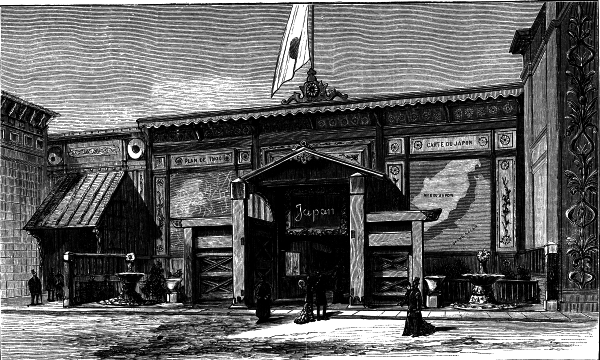Scientific American, Vol. XXXIX. No. 6. [New Series.], August 10, 1878, by Various, is part of the HackerNoon Books Series. You can jump to any chapter in this book here. THE JAPANESE BUILDING AT THE PARIS EXHIBITION.
THE JAPANESE BUILDING AT THE PARIS EXHIBITION.
Japan, on the terrestrial globe, lies furthest away in that direction beyond the Far West of America, and beyond the wide Pacific. The Japanese structure has a simple and solid aspect, resembling the portal of a half-fortified mansion, with massive timber frames at the sides; but it is adorned with two handsome porcelain fountains, and each of these is designed to represent the stump of a tree supporting a shell into which the water is poured from a large flower. Before entering the porch a large map of Japan and a plan of the city of Tokio are seen displayed on the walls to right and left.—Illustrated London News.
Machinery for New York State Capitol Building.
The Buckeye Engine Company of this city have been awarded the contract for a pair of condensing engines, cylinders 14 inches diameter, stroke 28 inches, for the State Capitol Building at Albany, New York. The engines will be of the company's usual horizontal type with automatic cut off, and will be elaborately finished.
The Explosiveness of Flour.
Professors Peck and Peckham, of the University of Minnesota, have been making an extensive series of experiments to determine the cause of the recent flour mill explosion at Minneapolis. The substances tested were coarse and fine bran, material from stone grinding wheat; wheat dust, from wheat dust house; middlings, general mill dust, dust from middlings machines, dust from flour dust house (from stones), and flour. When thrown in a body on a light, all these substances put the light out. Blown by a bellows into the air surrounding a gas flame, the following results were obtained:
Coarse bran would not burn. Fine bran and flour dust burn quickly, with considerable blaze. Middlings burn quicker, but with less flame. All the other substances burn very quickly, very much like gunpowder.
In all these cases there was a space around the flash where the dust was not thick enough to ignite from particle to particle; hence it remained in the air after the explosion. Flour dust, flour middlings, etc., when mixed with air, thick enough to ignite from particle to particle, and separated so that each particle is surrounded by air, will unite with the oxygen in the air, producing a gas at high temperature, which requires an additional space, hence the bursting.
There is no gas which comes from flour or middlings that is an explosive; it is the direct combination with the air that produces gas, requiring additional space. Powerful electric sparks from the electric machine and from the Leyden jar were passed through the air filled with dust of the different kinds, but without an explosion in any case. A platinum wire kept at a white heat by a galvanic battery would not produce an explosion. The dust would collect upon it and char to black coals, but would not blaze nor explode.
A piece of glowing charcoal, kept hot by the bellows, would not produce an explosion when surrounded by dust, but when fanned into a blaze the explosion followed. A common kerosene lantern, when surrounded by dust of all degrees of density, would not produce an explosion, but when the dust was blown into the bottom, through the globe and out of the top, it would ignite. To explode quickly the dust must be dry. Evidently when an explosion has been started in a volume of dusty air, loose flour maybe blown into the air and made a source of danger.
New Engineering Inventions.
Erskine H. Bronson, of Ottawa, Ontario, Canada, has patented an improvement in Automatic Switches for Railways, which consists in an arrangement of sliding cams for moving the switch rails, and in treadles to be operated by the pilot wheels of the locomotive, and in intermediate mechanism for connecting the treadles with the switch operating cams, the[Pg 88] object being to provide a switch will be operated by the pilot wheels of the locomotive as it approaches the movable switch rails.
An improved Refrigerator Car has been patented by Michael Haughey, of St Louis, Missouri. The object of this invention is to ventilate and cool railway cars used in the transportation of perishable articles. This car has a novel ventilator and ice box and is provided with a new form of non-conducting walls.
About HackerNoon Book Series: We bring you the most important technical, scientific, and insightful public domain books.
This book is part of the public domain. Various (2013). Scientific American, Vol. XXXIX. No. 6. [New Series.], August 10, 1878. Urbana, Illinois: Project Gutenberg. Retrieved https://www.gutenberg.org/cache/epub/19406/pg19406-images.html
This eBook is for the use of anyone anywhere at no cost and with almost no restrictions whatsoever. You may copy it, give it away or re-use it under the terms of the Project Gutenberg License included with this eBook or online at www.gutenberg.org, located at https://www.gutenberg.org/policy/license.html


